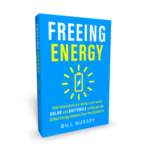
“In 2015, I was thinking of standing for Mayor of London. An interesting thing about politicians, apparently politicians in America run for things, whereas we, in Britain, we stand for them. It’s much more relaxing.
“I started New Energy Finance not as a do-gooder or as an environmentalist. I wanted to make some money, but I also wanted to do it while doing good. It was the single thing that I knew how to do that could accelerate this shift to a cleaner, lower-carbon, higher-performing, more just society, more just economy.
“I used to do this thing on Twitter called ‘The Chandeliers of Climate Change.’ I would take pictures of these extraordinary places where there would be dinners at various conferences, — the Élysée Palace and these fantastic hotels and restaurants and palaces and castles. Prince Charles has hosted various events at St. James’s Palace.
“Then I saw a tweet by a doctor in Sierra Leone and he tweeted a picture of an empty cot in the neonatal unit at his hospital and he said, ‘Tonight, there was a power cut and three of our babies died. That should not happen in this day and age with solar power.’
“I reached out to him and said, ‘You’re right. It shouldn’t happen, and I’ve got the network. If you can sort out the local end of things in Sierra Leone; if you can get the ministerial permissions and the hospital and you can get some land, I’ll raise the money and we’ll put a solar battery system in, robust, resilient, and we’ll stop this happening.’ And so fast-forward, we did exactly that. We raised about a hundred thousand pounds.
“The problem is we’re going to have this incredibly deeply electrified economy, and then there are times when that just doesn’t work. Between solar in the places where it’s really, really sunny and wind in the places where it’s really, really windy, we are going to get a long way to meeting humanity’s energy needs. But what about the monsoon, or if your interconnectors go down? Resilience — we’re going to have to think harder about resilience.
“My style is to try to think through what will the energy system look like in 2030, 2040, 2050, and then work back to see where the gaps are and who are the smart people working on those. The utilities that will survive will be digital native utilities. A utility is going to look much more like Facebook or LinkedIn than it’s going to look like PG&E, circa 1990 or 2000.”

Michael Liebreich, Chairman and CEO of Liebreich Associates, is one of the 320 people that author Bill Nussey interviewed for his book Freeing Energy: How innovators are using local-scale solar and batteries to disrupt the global energy industry from the outside in.
Learn more about Michael Liebreich from his Freeing Energy podcast with Bill Nussey.
You can see all the heroes (so far) and their stories here.
#HeroesofFreeingEnergy #320heroes #LocalEnergy #FreeingEnergybook
